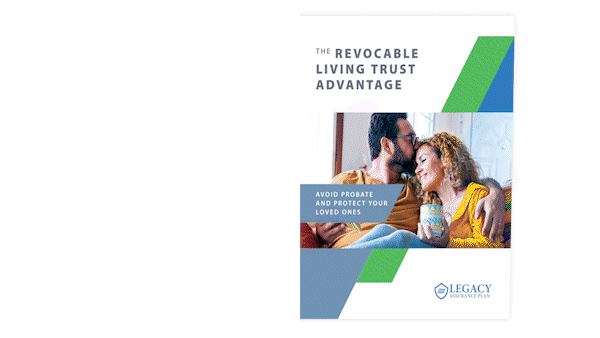In the realm of estate planning, a critical and often understated decision lies in designating beneficiaries for individual retirement accounts (IRAs) and 401(k)s. These accounts, often substantial components of one's financial legacy, require thoughtful consideration as to who will inherit these assets. Traditionally, the choice has leaned toward naming individuals — family members, friends or even charities — as beneficiaries. This direct approach is straightforward, ensuring that the designated parties receive the funds directly upon the account holder's death.
However, in recent years, a notable shift has been observed in this area of estate planning. More and more individuals are considering the option of naming a revocable living trust as the beneficiary of their IRAs and 401(k)s. This method is increasingly seen as a strategic alternative, offering various perceived advantages over the conventional practice. The appeal of using a revocable living trust lies primarily in the added control and flexibility it provides in managing and distributing these assets. It allows individuals to set specific terms and conditions under which the beneficiaries can access the funds, potentially ensuring a more responsible and beneficial use of the inheritance.
Despite its growing popularity, the decision to name a revocable living trust as a beneficiary is not without its complexities and risks. This approach can introduce a range of financial, legal and administrative challenges that are not typically present when naming individual beneficiaries. It is essential for account holders to understand these potential pitfalls, as well as the scenarios in which a trust might be a more appropriate beneficiary.
Why is a revocable living trust a key estate planning tool?
A revocable living trust, an increasingly common feature in estate planning, serves as a versatile legal arrangement offering significant control over one's assets. In essence, it is an agreement where a person, known as the grantor, entrusts another party, termed the successor trustee, with the responsibility to manage their assets. These assets are held in the trust for the benefit of a third party – the beneficiary. This legal structure is particularly appealing for several reasons, central among them being its flexibility and the level of control it affords the grantor over their assets.
One of the most compelling features of a revocable living trust is its flexibility. Unlike irrevocable trusts, which are fixed and cannot be changed once established, revocable trusts can be modified or completely dissolved at any time during the grantor’s lifetime. This adaptability is crucial, as it allows individuals to respond to changes in their personal circumstances, financial situations or estate planning goals.

For instance, a grantor could initially set up a trust that benefits their children equally. However, if circumstances change – say, one child develops a need for more financial support due to health issues – the grantor can adjust the trust’s terms to allocate more assets to that child. The ability to make such changes is a significant advantage over other estate planning tools that are more rigid in nature.
Another important reason people opt for revocable living trusts is to bypass the probate process. Probate is the legal procedure through which a deceased person's last will and testament is validated and their estate is distributed. Assets held in a revocable living trust, however, are not subject to probate. This means that upon the grantor’s death, the assets can be distributed to the beneficiaries more quickly, privately and often with fewer expenses.
When it comes to retirement accounts like IRAs and 401(k)s, direct beneficiary designations are a common practice. This method involves naming an individual or individuals who will inherit the account upon the account holder's death. While this approach is relatively straightforward and easy to set up, it lacks the level of control and flexibility offered by a trust.
With direct beneficiary designations, the account holder cannot impose conditions on how or when the beneficiaries will access the funds. Once the account holder passes away, the beneficiaries can generally use the funds as they see fit. In contrast, a revocable living trust allows the grantor to set specific terms for asset distribution – for example, disbursing funds when a beneficiary reaches a certain age or achieves a specific milestone, like graduation.
The appeal of naming trusts as beneficiaries
The practice of naming a trust as a beneficiary for IRAs and 401(k)s is gaining momentum in the realm of estate planning. This approach marks a significant departure from the traditional method of directly naming individuals as beneficiaries. It introduces a nuanced level of control and protection over the distribution of these assets, aspects that are becoming increasingly critical in today’s complex estate planning landscape.
One of the primary attractions of using trusts as beneficiaries for retirement accounts lies in the unparalleled control it affords the account holder over their assets. This control extends beyond their lifetime, allowing them to dictate not just who will receive the assets, but also how and when those assets will be distributed.
Trusts enable the specification of conditions under which beneficiaries can access the funds. For example, disbursements can be tied to age milestones, educational achievements or other life events.

Instead of a lump-sum distribution, trusts can be structured to distribute assets in stages, which can be particularly beneficial in managing the financial maturity and stability of younger beneficiaries.
Another significant advantage of naming a trust as a beneficiary is the level of protection it offers for the assets against potential legal and financial vulnerabilities of the beneficiaries.
Assets within a trust are generally shielded from the beneficiaries' creditors. If a beneficiary is facing legal issues, such as bankruptcy or divorce, the assets within the trust are often protected from claims and settlements.
Trustees have the discretion to withhold distributions if releasing funds could potentially harm the beneficiary, such as in cases where the beneficiary is struggling with creditor issues or substance abuse.
In families with complex dynamics or unique circumstances, the use of a trust offers solutions that a direct beneficiary designation cannot.
Trusts can ensure that assets are distributed in a way that respects the needs of both current and former family members, including children from previous marriages.
For beneficiaries with special needs, a trust can provide financial support without jeopardizing their eligibility for government assistance programs.
While trusts can introduce some tax complexities, they can also be part of a strategic financial plan.
With proper planning, trusts can be used to optimize the tax implications of transferring retirement assets, although this requires careful structuring to avoid potential pitfalls.
Trusts can be integrated into a broader financial strategy, taking into account the long-term financial goals and estate planning objectives of the account holder.
Protection against creditors and legal challenges

Another significant advantage of naming a trust as a beneficiary is the level of protection it can offer against creditors and legal disputes. When assets are transferred directly to individual beneficiaries, those assets can become vulnerable to claims from creditors, divorce settlements and other legal actions against the beneficiary. In contrast, assets held within a trust are generally protected from such claims, as the beneficiaries do not have direct control over them.
This protective feature is particularly valuable for grantors who are concerned about preserving their legacy and ensuring that their hard-earned assets are used for the benefit of their intended beneficiaries, rather than being diminished by external claims. By placing the retirement accounts within the shield of a trust, the trustor can provide a safeguard for these assets, ensuring that they are passed on intact to the beneficiaries as intended.
Risks and complications of naming a trust as a beneficiary
While the strategy of naming a trust as a beneficiary for retirement accounts like IRAs and 401(k)s offers distinct advantages, it's crucial to understand the associated risks and complications. These can impact the financial efficiency and legal simplicity of estate planning.
One of the primary concerns with naming a trust as a beneficiary is the potential for less favorable tax treatment. This issue can manifest in several ways:
- Accelerated distribution requirements. Trusts often face different and sometimes more accelerated distribution requirements than individual beneficiaries. For instance, while some individual beneficiaries might have the option to stretch the distributions over their lifetimes, trusts may be required to distribute the assets within a shorter timeframe. This accelerated distribution can lead to the trust’s income being taxed at higher rates.
- Higher tax rates for trusts. Trusts are subject to different tax brackets than individuals, with potentially higher rates kicking in at lower income levels. Consequently, the retirement assets within the trust could be taxed more heavily than if they were distributed directly to individual beneficiaries, potentially diminishing the overall value of the inheritance.
- Complex tax filing requirements: Trusts require separate tax filings and may be subject to complex tax rules, increasing the administrative burden and potential for costly mistakes.
Incorporating a trust as a beneficiary also introduces several legal and administrative layers that can complicate the estate planning process. Some of those complications include:
- Adherence to legal requirements. Trusts must comply with specific legal standards, including the terms under which they qualify as designated beneficiaries of retirement accounts. Failure to meet these requirements can lead to unfavorable tax consequences.
- Increased paperwork and management. Establishing and maintaining a trust involves significant paperwork, legal documentation and ongoing management. This can include drafting the trust document, continuously updating it to reflect changes in laws or personal circumstances and managing trust operations.
- Potential for legal disputes. Trusts, especially those with complex provisions or multiple beneficiaries, can be subject to disputes and legal challenges, potentially leading to litigation or court intervention.
Another consideration is the impact on required minimum distributions (RMDs). The way RMDs are handled can be significantly impacted when a trust is named as a beneficiary. Here are some considerations:
- Different RMD calculations. The method for calculating RMDs from an IRA or 401(k) can differ substantially when a trust is the beneficiary. The trust's structure and the ages of the beneficiaries can influence these calculations, potentially leading to larger RMDs over a shorter period.
- Potential for increased financial liabilities. If RMDs are larger or more accelerated, this could lead to increased tax liabilities for the trust. It can also mean that the beneficiaries receive their inheritance in larger, more immediate distributions, which might not align with the original intent of the trustor to preserve assets over the long term.
When to consider a trust as a contingent beneficiary

In certain situations, such as when beneficiaries have special needs or are minors, naming a trust as a contingent beneficiary can be beneficial. Trusts can provide for these unique circumstances while offering a level of control over the assets.
Naming a trust as a contingent beneficiary can allow for a balance between maintaining control over the retirement assets and mitigating some risks. This approach can safeguard assets while providing flexibility in their distribution.
Also, when considering a trust as a beneficiary for retirement accounts, it is essential to consult with estate planning professionals. Regular reviews and updates to the estate plan are crucial to ensure that the trust aligns with current laws and the trustor's intentions.
Conclusion
Naming a revocable living trust as the primary beneficiary of IRAs and 401(k)s carries potential risks, including unfavorable tax consequences and increased legal and administrative complexities. It is vital for individuals to make careful decisions and seek professional guidance in this process. By considering their unique circumstances and estate planning goals, individuals can make informed choices about whether naming a trust as a beneficiary is the best strategy for their retirement accounts.



